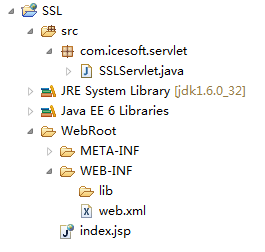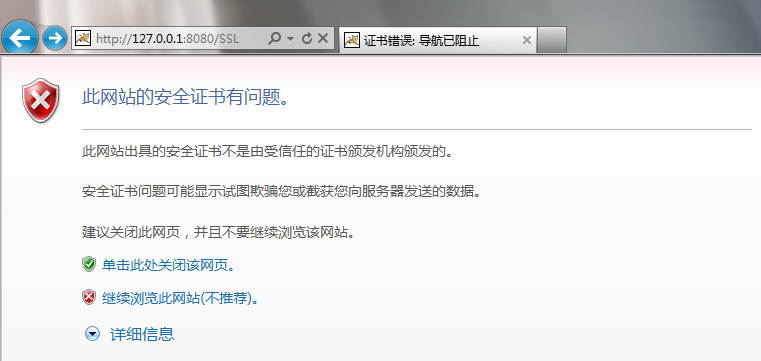Posted on 2012-06-04 17:36
IceWee 阅读(32984)
评论(22) 编辑 收藏 所属分类:
Java 、
Tomcat

SSL——Secure Sockets Layer双向认证(个人理解):
客户端认证:
客户端通过浏览器访问某一网站时,如果该网站为HTTPS网站,浏览器会自动检测系统中是否存在该网站的信任证书,如果没有信任证书,浏览器一般会拒绝访问,IE会有一个继续访问的链接,但地址栏是红色,给予用户警示作用,即客户端验证服务端并不是强制性的,可以没有服务端的信任证书,当然是否继续访问完全取决于用户自己。如何去除地址栏的红色警告呢?后续会介绍导入服务端证书到浏览器的方法。
服务端认证:
服务端需要获取到客户端通过浏览器发送过来的认证证书,该证书在服务端的证书库中已存在,仅仅是个匹配过程,匹配成功即通过认证,可继续访问网站资源,反之则无法显示网页,后续有截图。
基本逻辑:
1、生成服务端密钥库并导出证书;
2、生成客户端密钥库并导出证书;
3、根据服务端密钥库生成客户端信任的证书;
4、将客户端证书导入服务端密钥库;
5、将服务端证书导入浏览器。
构建演示系统
演示环境:
JDK:1.6.0_32
Tomcat:apache-tomcat-7.0.27
开发工具:MyEclipse 10
浏览器:Internet Explorer 9
一、生成密钥库和证书
可参考以下密钥生成脚本,根据实际情况做必要的修改,其中需要注意的是:服务端的密钥库参数“CN”必须与服务端的IP地址相同,否则会报错,客户端的任意。
key.script
 1、生成服务器证书库
1、生成服务器证书库

 keytool -validity 365 -genkey -v -alias server -keyalg RSA -keystore E:\ssl\server.keystore -dname "CN=127.0.0.1,OU=icesoft,O=icesoft,L=Haidian,ST=Beijing,c=cn" -storepass 123456 -keypass 123456
keytool -validity 365 -genkey -v -alias server -keyalg RSA -keystore E:\ssl\server.keystore -dname "CN=127.0.0.1,OU=icesoft,O=icesoft,L=Haidian,ST=Beijing,c=cn" -storepass 123456 -keypass 123456


 2、生成客户端证书库
2、生成客户端证书库

 keytool -validity 365 -genkeypair -v -alias client -keyalg RSA -storetype PKCS12 -keystore E:\ssl\client.p12 -dname "CN=client,OU=icesoft,O=icesoft,L=Haidian,ST=Beijing,c=cn" -storepass 123456 -keypass 123456
keytool -validity 365 -genkeypair -v -alias client -keyalg RSA -storetype PKCS12 -keystore E:\ssl\client.p12 -dname "CN=client,OU=icesoft,O=icesoft,L=Haidian,ST=Beijing,c=cn" -storepass 123456 -keypass 123456


 3、从客户端证书库中导出客户端证书
3、从客户端证书库中导出客户端证书

 keytool -export -v -alias client -keystore E:\ssl\client.p12 -storetype PKCS12 -storepass 123456 -rfc -file E:\ssl\client.cer
keytool -export -v -alias client -keystore E:\ssl\client.p12 -storetype PKCS12 -storepass 123456 -rfc -file E:\ssl\client.cer


 4、从服务器证书库中导出服务器证书
4、从服务器证书库中导出服务器证书

 keytool -export -v -alias server -keystore E:\ssl\server.keystore -storepass 123456 -rfc -file E:\ssl\server.cer
keytool -export -v -alias server -keystore E:\ssl\server.keystore -storepass 123456 -rfc -file E:\ssl\server.cer


 5、生成客户端信任证书库(由服务端证书生成的证书库)
5、生成客户端信任证书库(由服务端证书生成的证书库)

 keytool -import -v -alias server -file E:\ssl\server.cer -keystore E:\ssl\client.truststore -storepass 123456
keytool -import -v -alias server -file E:\ssl\server.cer -keystore E:\ssl\client.truststore -storepass 123456


 6、将客户端证书导入到服务器证书库(使得服务器信任客户端证书)
6、将客户端证书导入到服务器证书库(使得服务器信任客户端证书)

 keytool -import -v -alias client -file E:\ssl\client.cer -keystore E:\ssl\server.keystore -storepass 123456
keytool -import -v -alias client -file E:\ssl\client.cer -keystore E:\ssl\server.keystore -storepass 123456


 7、查看证书库中的全部证书
7、查看证书库中的全部证书

 keytool -list -keystore E:\ssl\server.keystore -storepass 123456
keytool -list -keystore E:\ssl\server.keystore -storepass 123456二、Tomat配置
使用文本编辑器编辑${catalina.base}/conf/server.xml
找到Connector port="8443"的标签,取消注释,并修改成如下:
 <Connector port="8443" protocol="org.apache.coyote.http11.Http11NioProtocol" SSLEnabled="true"
<Connector port="8443" protocol="org.apache.coyote.http11.Http11NioProtocol" SSLEnabled="true"
 maxThreads="150" scheme="https" secure="true"
maxThreads="150" scheme="https" secure="true"
 clientAuth="true" sslProtocol="TLS"
clientAuth="true" sslProtocol="TLS"
 keystoreFile="${catalina.base}/key/server.keystore" keystorePass="123456"
keystoreFile="${catalina.base}/key/server.keystore" keystorePass="123456"
 truststoreFile="${catalina.base}/key/server.keystore" truststorePass="123456"/>
truststoreFile="${catalina.base}/key/server.keystore" truststorePass="123456"/>备注:
keystoreFile:指定服务器密钥库,可以配置成绝对路径,如“D:/key/server.keystore”,本例中是在Tomcat目录中创建了一个名称为key的文件夹,仅供参考。
keystorePass:密钥库生成时的密码
truststoreFile:受信任密钥库,和密钥库相同即可
truststorePass:受信任密钥库密码
三、建立演示项目
项目结构图:
项目名称:SSL(随意)

SSLServlet.java
 package com.icesoft.servlet;
package com.icesoft.servlet;

 import java.io.IOException;
import java.io.IOException;
 import java.io.PrintWriter;
import java.io.PrintWriter;
 import java.security.cert.X509Certificate;
import java.security.cert.X509Certificate;

 import javax.servlet.ServletException;
import javax.servlet.ServletException;
 import javax.servlet.http.HttpServlet;
import javax.servlet.http.HttpServlet;
 import javax.servlet.http.HttpServletRequest;
import javax.servlet.http.HttpServletRequest;
 import javax.servlet.http.HttpServletResponse;
import javax.servlet.http.HttpServletResponse;


 /** *//**
/** *//**
 * <p>
* <p>
 * SSL Servlet
* SSL Servlet
 * </p>
* </p>
 *
*
 * @author IceWee
* @author IceWee
 * @date 2012-6-4
* @date 2012-6-4
 * @version 1.0
* @version 1.0
 */
*/

 public class SSLServlet extends HttpServlet
public class SSLServlet extends HttpServlet  {
{

 private static final long serialVersionUID = 1601507150278487538L;
private static final long serialVersionUID = 1601507150278487538L;
 private static final String ATTR_CER = "javax.servlet.request.X509Certificate";
private static final String ATTR_CER = "javax.servlet.request.X509Certificate";
 private static final String CONTENT_TYPE = "text/plain;charset=UTF-8";
private static final String CONTENT_TYPE = "text/plain;charset=UTF-8";
 private static final String DEFAULT_ENCODING = "UTF-8";
private static final String DEFAULT_ENCODING = "UTF-8";
 private static final String SCHEME_HTTPS = "https";
private static final String SCHEME_HTTPS = "https";

 public void doGet(HttpServletRequest request, HttpServletResponse response)
public void doGet(HttpServletRequest request, HttpServletResponse response)

 throws ServletException, IOException
throws ServletException, IOException  {
{
 response.setContentType(CONTENT_TYPE);
response.setContentType(CONTENT_TYPE);
 response.setCharacterEncoding(DEFAULT_ENCODING);
response.setCharacterEncoding(DEFAULT_ENCODING);
 PrintWriter out = response.getWriter();
PrintWriter out = response.getWriter();
 X509Certificate[] certs = (X509Certificate[]) request.getAttribute(ATTR_CER);
X509Certificate[] certs = (X509Certificate[]) request.getAttribute(ATTR_CER);

 if (certs != null)
if (certs != null)  {
{
 int count = certs.length;
int count = certs.length;
 out.println("共检测到[" + count + "]个客户端证书
out.println("共检测到[" + count + "]个客户端证书 ");
");

 for (int i = 0; i < count; i++)
for (int i = 0; i < count; i++)  {
{
 out.println("客户端证书 [" + (++i) + "]: ");
out.println("客户端证书 [" + (++i) + "]: ");
 out.println("校验结果:" + verifyCertificate(certs[--i]));
out.println("校验结果:" + verifyCertificate(certs[--i]));
 out.println("证书详细:\r" + certs[i].toString());
out.println("证书详细:\r" + certs[i].toString());
 }
}

 } else
} else  {
{

 if (SCHEME_HTTPS.equalsIgnoreCase(request.getScheme()))
if (SCHEME_HTTPS.equalsIgnoreCase(request.getScheme()))  {
{
 out.println("这是一个HTTPS请求,但是没有可用的客户端证书
out.println("这是一个HTTPS请求,但是没有可用的客户端证书 ");
");

 } else
} else  {
{
 out.println("这不是一个HTTPS请求,因此无法获得客户端证书列表
out.println("这不是一个HTTPS请求,因此无法获得客户端证书列表 ");
");
 }
}
 }
}
 out.close();
out.close();
 }
}

 public void doPost(HttpServletRequest request, HttpServletResponse response)
public void doPost(HttpServletRequest request, HttpServletResponse response)

 throws ServletException, IOException
throws ServletException, IOException  {
{
 doGet(request, response);
doGet(request, response);
 }
}


 /** *//**
/** *//**
 * <p>
* <p>
 * 校验证书是否过期
* 校验证书是否过期
 * </p>
* </p>
 *
*
 * @param certificate
* @param certificate
 * @return
* @return
 */
*/

 private boolean verifyCertificate(X509Certificate certificate)
private boolean verifyCertificate(X509Certificate certificate)  {
{
 boolean valid = true;
boolean valid = true;

 try
try  {
{
 certificate.checkValidity();
certificate.checkValidity();

 } catch (Exception e)
} catch (Exception e)  {
{
 e.printStackTrace();
e.printStackTrace();
 valid = false;
valid = false;
 }
}
 return valid;
return valid;
 }
}

 }
}

web.xml
说明:该演示项目强制使用了SSL,即普通的HTTP请求也会强制重定向为HTTPS请求,配置在最下面,可以去除,这样HTTP和HTTPS都可以访问。
 <?xml version="1.0" encoding="UTF-8"?>
<?xml version="1.0" encoding="UTF-8"?>
 <web-app version="3.0"
<web-app version="3.0"
 xmlns="http://java.sun.com/xml/ns/javaee"
xmlns="http://java.sun.com/xml/ns/javaee"
 xmlns:xsi="http://www.w3.org/2001/XMLSchema-instance"
xmlns:xsi="http://www.w3.org/2001/XMLSchema-instance"
 xsi:schemaLocation="http://java.sun.com/xml/ns/javaee
xsi:schemaLocation="http://java.sun.com/xml/ns/javaee
 http://java.sun.com/xml/ns/javaee/web-app_3_0.xsd">
http://java.sun.com/xml/ns/javaee/web-app_3_0.xsd">
 <display-name>Secure Sockets Layer</display-name>
<display-name>Secure Sockets Layer</display-name>

 <servlet>
<servlet>
 <servlet-name>SSLServlet</servlet-name>
<servlet-name>SSLServlet</servlet-name>
 <servlet-class>com.icesoft.servlet.SSLServlet</servlet-class>
<servlet-class>com.icesoft.servlet.SSLServlet</servlet-class>
 </servlet>
</servlet>
 <servlet-mapping>
<servlet-mapping>
 <servlet-name>SSLServlet</servlet-name>
<servlet-name>SSLServlet</servlet-name>
 <url-pattern>/sslServlet</url-pattern>
<url-pattern>/sslServlet</url-pattern>
 </servlet-mapping>
</servlet-mapping>

 <welcome-file-list>
<welcome-file-list>
 <welcome-file>index.jsp</welcome-file>
<welcome-file>index.jsp</welcome-file>
 </welcome-file-list>
</welcome-file-list>

 <!-- 强制SSL配置,即普通的请求也会重定向为SSL请求 -->
<!-- 强制SSL配置,即普通的请求也会重定向为SSL请求 -->
 <security-constraint>
<security-constraint>
 <web-resource-collection>
<web-resource-collection>
 <web-resource-name>SSL</web-resource-name>
<web-resource-name>SSL</web-resource-name>
 <url-pattern>/*</url-pattern><!-- 全站使用SSL -->
<url-pattern>/*</url-pattern><!-- 全站使用SSL -->
 </web-resource-collection>
</web-resource-collection>
 <user-data-constraint>
<user-data-constraint>
 <description>SSL required</description>
<description>SSL required</description>
 <!-- CONFIDENTIAL: 要保证服务器和客户端之间传输的数据不能够被修改,且不能被第三方查看到 -->
<!-- CONFIDENTIAL: 要保证服务器和客户端之间传输的数据不能够被修改,且不能被第三方查看到 -->
 <!-- INTEGRAL: 要保证服务器和client之间传输的数据不能够被修改 -->
<!-- INTEGRAL: 要保证服务器和client之间传输的数据不能够被修改 -->
 <!-- NONE: 指示容器必须能够在任一的连接上提供数据。(即用HTTP或HTTPS,由客户端来决定)-->
<!-- NONE: 指示容器必须能够在任一的连接上提供数据。(即用HTTP或HTTPS,由客户端来决定)-->
 <transport-guarantee>CONFIDENTIAL</transport-guarantee>
<transport-guarantee>CONFIDENTIAL</transport-guarantee>
 </user-data-constraint>
</user-data-constraint>
 </security-constraint>
</security-constraint>
 </web-app>
</web-app>index.jsp

 <%
<% @ page language="java" pageEncoding="UTF-8"%>
@ page language="java" pageEncoding="UTF-8"%>

 <!DOCTYPE HTML PUBLIC "-//W3C//DTD HTML 4.01 Transitional//EN">
<!DOCTYPE HTML PUBLIC "-//W3C//DTD HTML 4.01 Transitional//EN">
 <html>
<html>
 <head>
<head>
 <title>客户端证书上传</title>
<title>客户端证书上传</title>
 <meta http-equiv="pragma" content="no-cache">
<meta http-equiv="pragma" content="no-cache">
 <meta http-equiv="cache-control" content="no-cache">
<meta http-equiv="cache-control" content="no-cache">
 <meta http-equiv="expires" content="0">
<meta http-equiv="expires" content="0">
 </head>
</head>
 <body>
<body>
 <form action="${pageContext.request.contextPath}/sslServlet" method="post">
<form action="${pageContext.request.contextPath}/sslServlet" method="post">
 <input type="submit" value="提交证书"/>
<input type="submit" value="提交证书"/>
 </form>
</form>
 </body>
</body>
 </html>
</html>四、演示及配置
发布演示项目,通过浏览器访问:
http://127.0.0.1:8080/SSL或
https://127.0.0.1:8443/SSL,得到相同的结果,如图:


得到如上结果的原始是因为客户端没有通过服务端的安全认证,接下来将服务端给客户端颁发的证书导入到浏览器中:
双击“client.p12”

弹出窗口,下一步

默认,下一步

输入生成密钥时的密码“123456”,下一步

下一步

完成

成功

再次访问
http://127.0.0.1:8080/SSL或
https://127.0.0.1:8443/SSL,弹出提示框:

点击确定后,IE浏览器自动阻止了继续访问,并给予警告提示,原因是浏览器中未导入该网站的可信证书


点击“继续浏览此网站”,弹出提示,点击确定

哇!鲜红的地址栏,够醒目吧!你访问的网站不安全那,亲!

点击“提交证书”按钮,返回正确结果!

可以看出,客户端并没有服务端那么严格,只要未通过验证就甭想访问,下面将服务端生成的信任证书导入到浏览器的根证书中,这样红色的地址栏就会消失了!
开始导入服务端信任证书,不能双击“server.cer”,需要手动导入到受信任的根证书机构中去。

浏览器Internet选项-内容-证书

点击“受信任的根证书颁发机构”

点击“导入”

下一步

手动选择“server.cer”,下一步

下一步

完成

点“是”

成功

可以看到我们刚刚导入的根证书

把所有浏览器窗口都关掉,再次访问网站,发现鲜红色已经逝去

点击“提交证书”按钮,一切正常了,双向认证的DEMO结束了!

全文完!